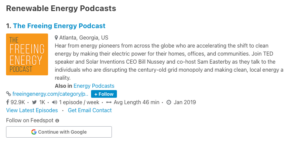
Every four years, one thousand solar scientists from across the world gather to peer into the future of the solar industry. The event is called the World Conference on Photovoltaic Energy Conversion (WCPEC). The seventh such event is taking place this week on the big island of Hawaii.
I decided to attend the conference to learn about the underlying scientific trends shaping the solar industry. If scientists are excited about something today, there’s a good chance it may become a commercial product in the next few years. And, if you want to understand how the cost of solar will continue its industry-changing decent, many of the best ideas are being presented here.
How does a solar science conference work?
The conference covers about 1,200 topics. They are broken across a handful of big speeches for all attendees (“plenary” talks), a few hundred 15-minute breakout room presentations (called “orals”), and the remaining being a room full of scientists, each standing next to a big printout of their research, answering questions as people walk by (called “posters”). The topics are divided into ten areas including technical topics like “Perovskite and Organic Solar Cells” and industry topics like “Grid Integration, Policy, Deployment & Sustainability.”
Looking across the presenters and talks, four big topic areas rose above the rest:
- Perovskite solar cells
- Bifacial solar cells
- Longevity of cells and panels
- Recyclability of panels
Perovskites – a brand new approach that promises substantially cheaper solar
Nearly all the solar cells made over the last few decades are based on the earth’s most common element, silicon. While it may be common, silicon is very expensive to purify leaving plenty of room for less expensive alternatives.
Enter perovskites.
This common mineral was first used for solar power in 2009. Since then, research around it has taken off. If early success is any indicator, perovskites hold the promise of far cheaper solar cells. Perovskites have improved faster than any other photovoltaic technology. It took silicon decades to reach today’s 20%-plus efficiency levels. Perovskites reached those levels in under 10 years. Their materials could be as much as 3-8x cheaper than a traditional silicon solar cell.
And, they are also much simpler to make because perovskite cells can be made continuously – similar to printing newspapers on a giant press.
The challenge for perovskite cells is that they degrade quickly, particularly when exposed to humidity. The earliest cells quit working within minutes but years of scientific work has extended that lifetime to over a year in some cases. This is still short of silicon’s 20-30 year lifetime but the progress is promising. The perovskite scientists I’ve talked with are optimistic but their silicon-focused counterparts remain skeptical. Time will tell.
Regardless of which cell chemistry becomes the long-term cost leader, the progress to date with silicon is nothing short of amazing. It has been so successful that the cells, themselves, only make up about 8%[1] of the full cost of a solar installation (the rest is things like land, inverters, financing, etc). So, even if perovskites can cut cell cost by half, the impact on overall costs may only be a few percentage points.
if you like TED talks and you’d like to learn more about perovskites, check out this video from MIT physicist, Sam Stranks: https://www.youtube.com/watch?v=2ccar3uqWsw
Bifacial cells – generating electricity from both sides of a cell
While much of the solar science at the conference is focused on eking out every last hundredth-of-a-percent of efficiency from a cell, bifacial cells take a different approach by allowing more light to be absorbed by the cell. Traditional solar cells can only absorb light from their front. While it complicates the manufacturing, bifacial cells can absorb light from both front and back. It turns out this can make a huge difference. Grass, roofs, sand and other places where solar panels get installed all reflect a surprising amount of light. Bifacial cells capture that light and can add 10% to 30% more power from a given cell. Much of the bifacial research focuses on minimizing the additional manufacturing costs and determining the best venues for utilizing these new cells.
Longevity and recyclability
A decade or two ago, solar was expensive and limited to early adopters. All that has changed. Solar is now the fastest growing source of energy and many experts believe that it will become the predominant source of energy in coming decades. Contemplating a world with 10 or 20 times more solar raises some interesting questions. How long will solar panels continue running and what do we do with when they finally quit working?
Nearly all solar panels are warranted for 20-25 years. Some solar panels deployed 40 years ago continue to run. Ironically, the main reason solar panels degrade is the same reason anything you leave outside degrades – relentless exposure to sunlight breaks down the materials. Many of the scientists at the conference are investigating the details of these breakdowns so panel lifetime can be extended for years or even decades.
Nonetheless, at some point, every solar panel will have to be taken out of commission. Fortunately, nearly all the materials in panels are simple and easy to reuse: aluminum, silicon, silver, and copper.
Unfortunately, the current price-focused way panels are manufactured makes it expensive to disassemble the panels and extract these materials. The scientists here are working on creative new ways to make panels that will hopefully solve this challenge without adding any significant costs.
The Freeing Energy Perspective
Only one thing really shocked me at this conference: one of the scientists was wearing shorts with dark socks. Beyond that, there were a few smaller surprises, too. Half-cells and quarter-cells, arguably one of the biggest trends in solar, were not mentioned directly in any presentation. Also, integration with batteries, which are the newest best-friends for solar, was largely absent. Lastly, even though China manufactures 70% of the world’s solar and is now the largest market for solar, the number of Chinese scientists was relatively tiny (the implications of this are unclear but probably important).
All in all, this conference reflected the broad consensus on the industry’s roadmap. Progress is rarely defined by huge, headline-making breakthroughs. Instead, it’s made through countless discussions at events like this. Each relatively small breakthrough contributes its part to the relentless improvement of the solar juggernaut.
[1] According to NREL (page 21), the module costs are 35c out of $2.80 installation, about 13%. And cells account for about two-thirds the cost of a module. This leaves the cells at about 8% of total solar costs.




2 Responses
Great overview of the conference Bill. Interesting to learn more about the areas you highlighted that went largely missing. The lack of discussion around the integration with battery storage is fascinating, but do you think that it because these scientists were focused only on solar breakthroughs and therefore battery storage is simply outside of their scope of expertise? But seems shortsighted since the future of the energy industry is these two technologies wed at the hip.
I asked myself the same thing. Even without shifting into battery science, I think there are areas that solar scientists could address as battery penetration increases. For example, what are the opportunities of DC-to-DC connected PV battery charging? Is it feasible to do fast DC charging for EVs directly with PV? I saw some mentions of these things but they were dwarfed by areas like PV for outerspace (e.g. relatively tiny market). I could argue that answers to questions like these will do more for the future of PV than another 0.1% in effeciency using materials that are unlikely to ever be commercially viable. In short, I think this group of scientists is looking into many of the biggest opportunities for a better PV future but there are many areas still largely unexplored.